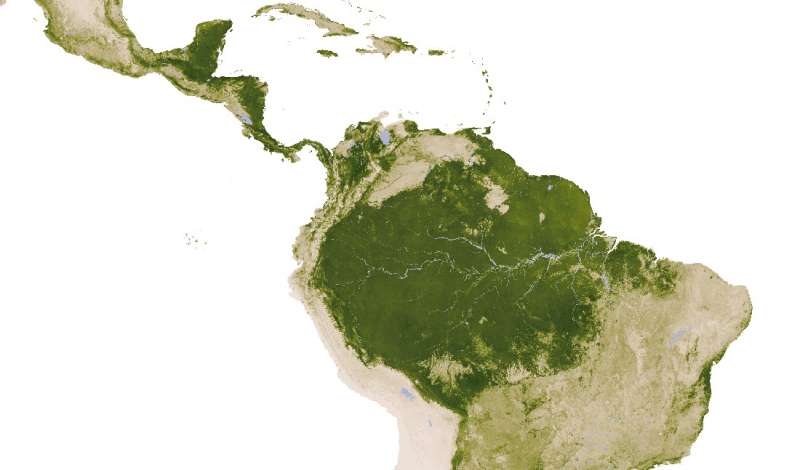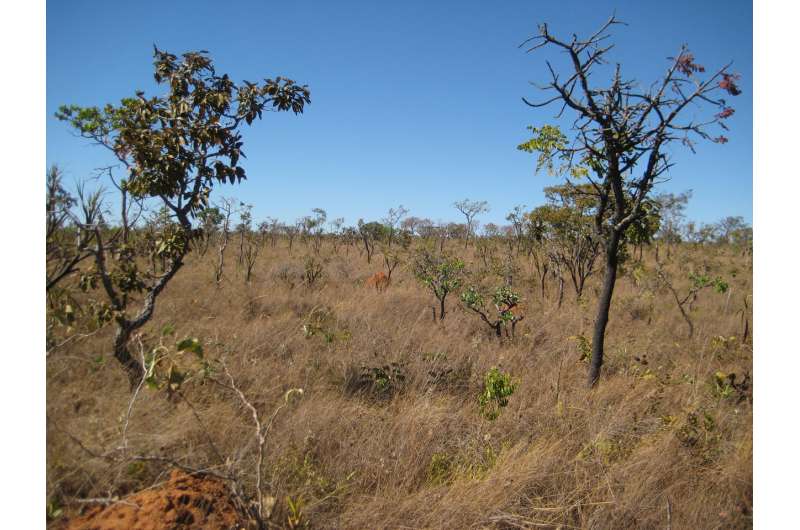Map of vegetation in the Amazon (dark green) and adjoining savanna (light green) as reflected in the Leaf Area Index based on satellite MODIS data. Credit: NASA Earth Observatory, Robert Simmons
New research suggests that the boundary between South American tropical rainforests and savannas is influenced by the depth to which plants can root. Shallow rooting depth promotes the establishment of savannas. Previous research has shown that precipitation and fire mediate tropical forest and savanna distributions. The study shows that below ground conditions need to be considered to understand the distribution of terrestrial vegetation both historically and in the face of future climate change. The study by researchers of the Senckenberg Biodiversity and Climate Research Centre and Goethe University is based on computer vegetation models and was published in Journal of Biogeography.
There are models and there is the reality; and in some cases they just don't match. This is what Liam Langan and his team at the Senckenberg Biodiversity and Climate Centre found when looking at the natural boundary between the lush Amazonian rainforest and the adjoining savanna with sparsely spaced trees, known as the Brazilian Cerrado. Simulation results from computer models and data gained from satellite MODIS on this area don't agree.
Soils appear to lie at the root of the problem. "That fire and precipitation mediate tropical rainforest and savanna biome boundaries has been established empirically and included in models," says Langan. Although known to have an impact, soil depth is usually not taken properly into account in computer vegetation models. Instead these models generally assume a constant soil depth of two to three meters globally.
The researchers found however that the probability of observing a rainforest or savanna at a given point in the Amazonas-Cerrado region hinges on a complex interplay of precipitation, fire and tree rooting depth. When precipitation is above ca. 2.500mm annually, the depth to which trees can root weakly affects which vegetation state is observed and rainforest dominates. However, where precipitation is below 2.500 mm annually, both rainforest and savanna are possible.
Brazilian Cerrado with sparsely spaced trees. Credit: Simon Scheiter
"If trees have access to a larger volume of soil, this promotes more wooded vegetation whereas shallower rooting, lower precipitation and fire promote less wooded, grass dominated vegetation zones. It's all about water availability: Access to deeper soil layers typically increases the total amount of soil water available to plants which in turn favors tropical rainforest with its evergreen trees. It doesn't stop there though, these interactions also alter plant communities composition and diversity," explains the research group leader Dr. Simon Scheiter, Senckenberg Biodiversity and Climate Research Centre.
This knowledge enables scientists to improve vegetation models and heighten their capability to accurately predict future vegetation changes in these areas. Langan: "This area is about the size of Europe. The Amazonian rainforest is a biodiversity hotspot and one of the world's major carbon stores. Predicting how this area's vegetation might respond to changing conditions is by no means trivial. More accurately modelling how constraints on plant rooting influence vegetation formations will help elucidate how this area will respond to climate change."
More information: Liam Langan et al. Climate-biomes, pedo-biomes or pyro-biomes: which world view explains the tropical forest-savanna boundary in South America?, Journal of Biogeography (2017). DOI: 10.1111/jbi.13018
Journal information: Journal of Biogeography























